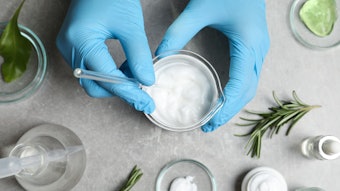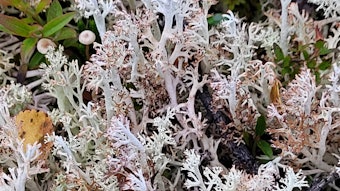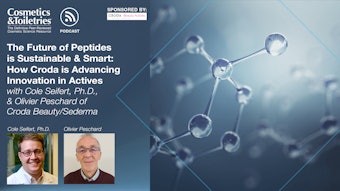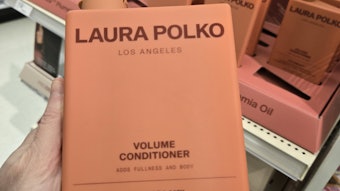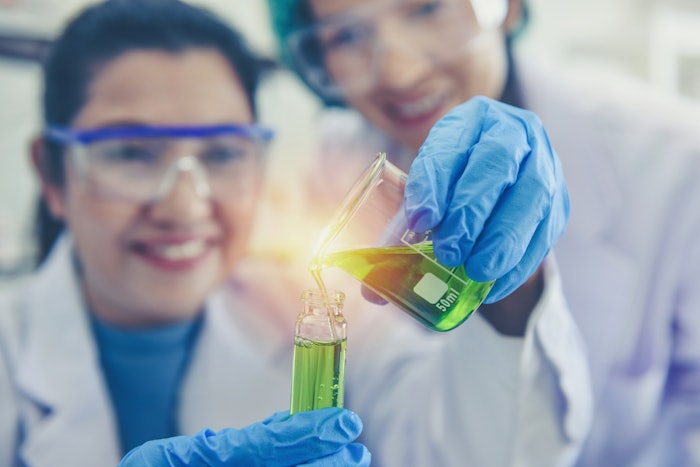
Editor’s note: Cosmetics & Toiletries is delighted to welcome the latest addition to its regularly featured content lineup: Biotechnology in Beauty. This column will delve into the thriving biotech field as it pertains to beauty and personal care, providing insights from a cosmetic chemist’s perspective about the current state of the art, challenges and triumphs, how biotech is evolving and more.
This article is only available to registered users.
Log In to View the Full Article
Editor’s note: Cosmetics & Toiletries is delighted to welcome the latest addition to its regularly featured content lineup: Biotechnology in Beauty. This column will delve into the thriving biotech field as it pertains to beauty and personal care, providing insights from a cosmetic chemist’s perspective about the current state of the art, challenges and triumphs, how biotech is evolving and more.
Leading the charge is biotech expert Krupa Koestline, chief formulator and owner of KKT Innovation Labs and the 2024 recipient of the Florence Wall Women in Cosmetic Chemistry Award. Here, she opens the series with a commentary about how biotechnology shaped her education and career, and an overview of its benefits for beauty innovation. Future installments will explore specific types of biotechnology, the latest advances, and ingredient and product examples.
I remember sitting cross-legged on the living room floor, eyes glued to the television as the news broke about “Dolly” – the first mammal cloned from an adult cell. It was 1996, and while the world buzzed about the ethics of cloning a sheep, my teenage mind was spinning with excitement. Here, I thought, was science touching magic.
Around that same time, headlines about the Human Genome Project filled the news. This groundbreaking international effort sought to decode some three billion letters of human DNA.1 Biotechnology, or the use of living systems or organisms to create products and technologies, had captured my imagination
These events didn’t just shape headlines, they shaped my life. Fascinated by the ability of science to rewrite the very code of life, I pursued both a bachelor’s and master’s degree in biotechnology, diving deeply into genetic engineering – the domain of directly manipulating genes to achieve desired characteristics. My early years in the lab were spent sequencing DNA, culturing cells and exploring how tiny genetic tweaks could unlock enormous potential.
While my path shifted unexpectedly from genetic engineering to beauty and skin care formulation, biotechnology remained my North Star, guiding my work as a cosmetic chemist and inspiring me to found my company, which applies biotech solutions to create sustainable, safe and cutting-edge beauty products.
But biotechnology in beauty isn’t entirely new. It’s been quietly shaping the industry for decades. Why, then, should we be especially excited now? Let me take you behind the scenes — explaining biotech’s deep impact on sustainability, quality, innovation and accessibility, with some fascinating examples and a little bit of technical magic along the way.
Biotechnology’s Quiet Legacy in Beauty
You might not realize it, but biotechnology has been influencing beauty formulations for years. When I started formulating skin care products, biotechnology was already quietly at work behind some of beauty’s favorite ingredients — think enzymes in exfoliators, yeast-derived peptides in anti-aging creams, and vitamins made by microbial fermentation rather than extracted from plants.
Today, however, biotech is moving from behind-the-scenes helper to headline innovator, transforming how we create products. The beauty world is finally awakening to its immense possibilities.
Sustainability
One of biotechnology’s most profound benefits is sustainability. In my early days of formulating skin care, I noticed a troubling contradiction: many ingredients praised as natural often required intensive farming or harvesting practices that could harm ecosystems. The solution was biotechnology.
To illustrate this, consider hyaluronic acid – one of beauty’s favorite hydrating ingredients. In the past, hyaluronic acid was extracted directly from rooster combs and animal tissues. This process was not only ethically concerning, but also inconsistent and prone to contamination.
Biotechnology provided a groundbreaking solution. Scientists discovered they could produce pure hyaluronic acid through microbial fermentation.2, 3 Technically speaking, certain strains of bacteria – often the harmless species Streptococcus zooepidemicus – are cultured in bioreactors under strictly controlled conditions. These microbes ferment sugars, converting them into pure hyaluronic acid molecules identical to those found in human skin.
The result? A cruelty-free, ethically produced cosmetic ingredient with consistent purity, potency and performance.
Another example is from a recent internal project where we created an eye gel using biotech-derived peptides grown through fermentation processes. This delivered powerful results without environmental harm.4-6 Biotechnology allows beauty to innovate sustainably — delivering what consumers want without damaging our planet’s precious resources.
Ethics, Precision and Purity
Growing up vegetarian, I’ve always felt strongly about the ethical implications of ingredient sourcing, especially when it comes to animal-derived ingredients. And with Research and Markets predicting the vegan cosmetics market will reach $21.79 billion by 2034, clearly I’m not alone.7
Collagen, for example, was traditionally extracted from animal tissues such as bovine hides or fish skin for use in anti-aging products and supplements. To me, using animal-based sources always felt ethically challenging and contrary to my values.
Biotechnology, however, provides an elegant, compassionate solution. Today, through the process of precision fermentation, scientists can produce pure human-identical collagen without animals. Here’s how it works.
Using recombinant DNA technology – wherein specifically designed DNA sequences are inserted into microorganisms like yeast – scientists effectively program the host yeast cells to express human-identical collagen. These yeast cells are cultured in carefully controlled bioreactors, where they reliably produce pure, allergen-free collagen molecules identical to those naturally found in our skin.8
Biotechnology can also benefit botanically extracted molecules. Botanical extraction often requires intensive purification processes, consuming large amounts of energy and resources yet still struggling to yield consistently pure compounds. By using recombinant DNA technology, these exact botanical molecules can be sustainably and precisely produced in laboratories, significantly reducing the environmental impact while guaranteeing consistency and purity.9, 10
Democratizing Beauty
Back when Dolly the sheep made headlines, biotechnology seemed futuristic – something only labs with enormous resources could access. Today, it’s democratizing beauty.
Ingredients that were once rare and prohibitively expensive – such as squalane from shark liver, or even fragrance from botanicals that no longer exist – can now be made through biotechnology, ethically and more affordably.
In fact, as an article in Biotechnology Healthcare explained, as the biotech industry matures, companies are finding ways to improve efficiency, reduce costs through economies of scale, and benefit from collaborations.11 What’s more, the Boston Consulting Group noted how, by optimizing large-scale facilities and improving strains, “the potential for cost reduction in biomanufacturing is significant, potentially reaching 50% or even 90% in some cases.”12
An example of this is sugarcane-derived squalane created through fermentation; something we champion internally. In simple terms, microbes feed on sugars and create a broth, which is then filtered for farnesene and transformed into pure squalane molecules – identical in efficacy to their traditional counterparts. This approach dramatically lowers costs, making previous luxury ingredients accessible to a much wider audience.
Innovating Beyond Nature
Perhaps the most thrilling potential for biotechnology is its potential to transform plants themselves into living factories for powerful skin care ingredients — a concept that once felt like science fiction, now becoming reality. Again, using recombinant DNA technology, scientists can insert specific genetic codes into plants, effectively turning them into biofactories that produce valuable skin care molecules – like peptides and growth factors – right inside their leaves, stems and roots.
Several pioneering biotech companies are already engineering tobacco and rice plants to produce human growth factors and peptides directly within the plant tissues.13-15 These plants are grown sustainably, harvested responsibly and processed to extract high-purity active ingredients, bypassing traditional resource-intensive chemical synthesis or animal-based extraction entirely.
Additionally, biotech firms are actively discovering and creating entirely novel peptides – short, targeted amino acids – to address specific skin care concerns at the cellular level. By manipulating peptide structures using biotechnology, scientists can engineer precise, targeted solutions for issues like wrinkles, pigmentation or even inflammation in ways nature alone could never achieve.9, 16, 17
Challenges are Invitations
Of course, biotechnology isn’t without hurdles. Scaling biotech ingredients requires investment, education and overcoming regulatory complexities.18-20 But these challenges can be viewed as invitations. They are chances to educate, innovate and build a better, stronger, more transparent industry. Biotechnology doesn’t just promise innovation, it demands responsibility and transparency from brands.
Another hurdle is consumer perception. Despite its transformative potential, the term biotech can still feel mysterious or intimidating. Beauty consumers often equate naturalness with simplicity, assuming simpler sourcing equals safer products. Biotechnology challenges this notion, redefining what it means to be natural.
I’ve encountered this skepticism first-hand from clients who instinctively perceived “lab-made” as artificial or unnatural. Recognizing this led me to embrace education and open communication as central parts of my role. It became clear that explaining biotech openly and authentically would be essential in shaping a brands’ and therefore consumers’ understanding and acceptance.
As cosmetic chemists and brand leaders, our roles extend beyond formulation. We must actively educate consumers about the safety, sustainability and ethical advantages of biotech ingredients. By transparently explaining how biotech works – whether precision fermentation, bioengineering or plant cell cultures – we can build trust, transforming uncertainty into curiosity and excitement.
Why the Beauty Industry Should Embrace Biotechnology Now
Reflecting on my journey from the dream of cloning organisms, to decoding genes and pioneering biotech-driven skin care, I’ve learned that beauty and biotechnology share one essential characteristic: the promise of transformation. My journey from a wide-eyed teenager inspired by biotechnology to a cosmetic chemist harnessing biotech’s extraordinary potential has brought clarity to my mission: to innovate responsibly, honor our environment and democratize beauty.
I invite you to join me in marveling and embracing the limitless possibilities of biotechnology for beauty. Because when beauty and biotechnology meet, the possibilities are truly limitless.
References
- National Human Genome Research Institute. (Accessed 2025, Jul 16). Human genome project. Available at https://www.genome.gov/about-genomics/educational-resources/fact-sheets/human-genome-project
- Grabowski, M., Gmyrek, D., Żurawska, M. and Trusek, A. (2025). Hyaluronic acid: Production strategies, gel-forming properties and advances in drug delivery systems. Gels. Available at https://www.mdpi.com/2310-2861/11/6/424
- Marwan-Abdelbaset, E., Samy-Kamal, M., Tan, D. and Lu, X. (2025, Jul). Microbial production of hyaluronic acid: The current advances, engineering strategies and trends. J Biotechnology. Available at https://www.sciencedirect.com/science/article/abs/pii/S0168165625000732
- Singh, B.P. (2025, May 22). Harnessing probiotic fermentation for the generation of food-derived bioactive peptides: Current status and prospects. Springer Nature. Available at https://link.springer.com/article/10.1007/s00217-025-04774-2
- Wang, W., Peng, G., Sun, J., Jiang, C. Hao, J. and Zhang, X. (2025). Screening and characterization of marine Bacillus atrophaeus g4 protease and its application in the enzymatic hydrolysis of sheep (Ovis aries) placenta for the preparation of antioxidant peptides. Molecules. Available at https://www.mdpi.com/1420-3049/30/10/2217
- Cambrium. (Accessed 2025, Jul 16). Novacoll. Available at https://www.cambrium.bio/products
- Research and Markets. (2024, Sep 9). Vegan cosmetics and personal care ingredients industry research 2024-2034: Rising demand for transparency in ingredient sourcing and product formulations and awareness of cruelty-free products. Available at https://www.globenewswire.com/news-release/2024/09/09/2942635/28124/en/Vegan-Cosmetics-and-Personal-Care-Ingredients-Industry-research-2024-2034-Rising-Demand-for-Transparency-in-Ingredient-Sourcing-and-Product-Formulations-and-Awareness-of-Cruelty-Fr.ht
- Olsen, D.R., Hitzeman, R.A., Chrisholm, C., CHang, R. and McMullin, H. (Accessed 2025, Jul 16). European Pat EP0967226A3. Methods for the production of fibrillar collagen. Available at https://patents.google.com/patent/EP0967226A3/en
- Lipotrue. (Accessed 2025, Jul 16). Telessence Telmeric. Available at https://lipotrue.com/products/telessence-telmeric/
- Vytrus Biotech. (Accessed 2025, Jul 16). Turmeria Zen: The emotional wellbeing manager. Available at https://www.vytrus.com/natural-active/turmeria-zen/
- Edelman, B. (2004, May). Explaining the cost of biotech therapies. Biotechnology Healthcare. Available at https://pmc.ncbi.nlm.nih.gov/articles/PMC3555164/
- Bobier, J.-F., Cerisy, T., Coulin, A,-D., Bleecher, C., Sassoon, V. and Alexander, B. (2024, Feb 27). Breaking the cost barrier on biomanufacturing. BCG. Available at https://www.bcg.com/publications/2024/breaking-the-cost-barrier-on-biomanufacturing#:~:text=Key%20Takeaways,reach%20$200%20billion%20by%202040.
- Staub, J.M., Garcia, B., ... Russell, A., et al. (2000, Mar). High-yield production of a human therapeutic protein in tobacco chloroplasts. Nat Biotechnol. Available at https://pubmed.ncbi.nlm.nih.gov/10700152/
- Ahmadabadi, M. (2021, Oct 1). Transfer and expression of native human insulin-like growth factor-1 in tobacco chloroplasts. Iran J Biotech. Available at https://pubmed.ncbi.nlm.nih.gov/35350639/
- Wasaka, Y. and Takaiwa, F. (2013, Oct). The use of rice seeds to produce human pharmaceuticals for oral therapy. Biotech J. Available at https://pubmed.ncbi.nlm.nih.gov/24092672/
- Zonari, A., Brace, L.E., ... Carvalho, J.L., et al. (2024, Feb 23). Double-blind, vehicle-controlled clinical investigation of peptide OS-01 for skin rejuvenation. J Cosmet Derm. Available at https://onlinelibrary.wiley.com/doi/10.1111/jocd.16242
- Evolved by Nature. (Accessed 2025, Jul 16). Creating new molecules for a healthier future. Available at https://biotech.evolvedbynature.com/
- Gross, M. (1984). Biotechnology: The regulatory revolution. Nature Biotechnology. Available at https://www.nature.com/articles/nbt0484-342
- Tachikawa, M., and Matsuo, M. (2024, Feb 22). Global regulatory trends of genome editing technology in agriculture and food. Breeding Science. Available at https://pmc.ncbi.nlm.nih.gov/articles/PMC11375430/
- Furgurson, J., Loschin, N., ..., Mainello, A., et al. (2023, Aug). Seizing the policy moment in cropbiotech regulation: An interdisciplinary response to the Executive Order on biotechnology. Frontiers in Bioengineering and Biotech. Available at https://pmc.ncbi.nlm.nih.gov/articles/PMC10441231/
